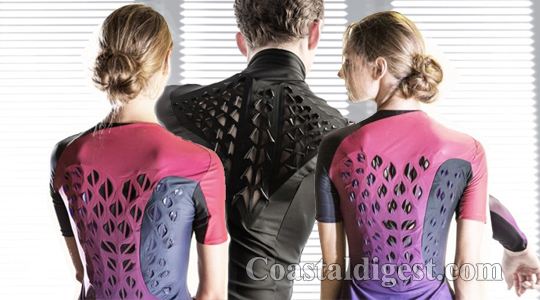May 23: If sweating is your problem with workouts, Massachusetts Institute of Technology (MIT) researchers have a new solution to offer. They have designed a breathable workout suit that can keep the body cool and dry in the gym.

The workout suit has ventilating flaps that open and close in response to the body’s heat and sweat, and can make one feel like, in the words of one of the researchers, wearing an “air conditioner” on the back. Powered by harmless microbes built into the fabric, these flaps, which range from thumbnail- to finger-sized, shrink and expand in response to changes in humidity.
“This work is an example of harnessing the power of biology to design new materials and devices and achieve new functions,” said Xuanhe Zhao, Associate Professor in the Department of Mechanical Engineering and study co-author. The microbial cells act as tiny sensors and actuators, driving the flaps to open when an athlete works up a sweat, and pulling them closed when the body has cooled off, the researchers described in a paper published in the journal Science Advances.
The paper also describes a running shoe with an inner layer of similar cell-lined flaps to air out and wick away moisture. In trials to test the running suit, study participants donned the garment and worked out on exercise treadmills and bicycles while researchers monitored their temperature and humidity using small sensors positioned across their backs.
After five minutes of exercise, the suit’s flaps started opening up, right around the time when participants reported feeling warm and sweaty. According to sensor readings, the flaps effectively removed sweat from the body and lowered skin temperature, more so than when participants wore a similar running suit with nonfunctional flaps.
But why use live cells in responsive fabrics? Because moisture-sensitive cells require no additional elements to sense and respond to humidity, the researchers said. What is more, with new genetic engineering tools available today, cells can be prepared quickly and in vast quantities, to express multiple functionalities in addition to moisture response.
To demonstrate this last point, the researchers engineered moisture-sensitive cells to not only pull flaps open but also light up in response to humid conditions. “We can combine our cells with genetic tools to introduce other functionalities into these living cells,” said Wen Wang, the paper’s lead author and a former research scientist in MIT’s Media Lab and Department of Chemical Engineering.
“We use fluorescence as an example, and this can let people know you are running in the dark. In the future we can combine odour-releasing functionalities through genetic engineering. So maybe after going to the gym, the shirt can release a nice-smelling odor,” Wang said.






Comments
Add new comment